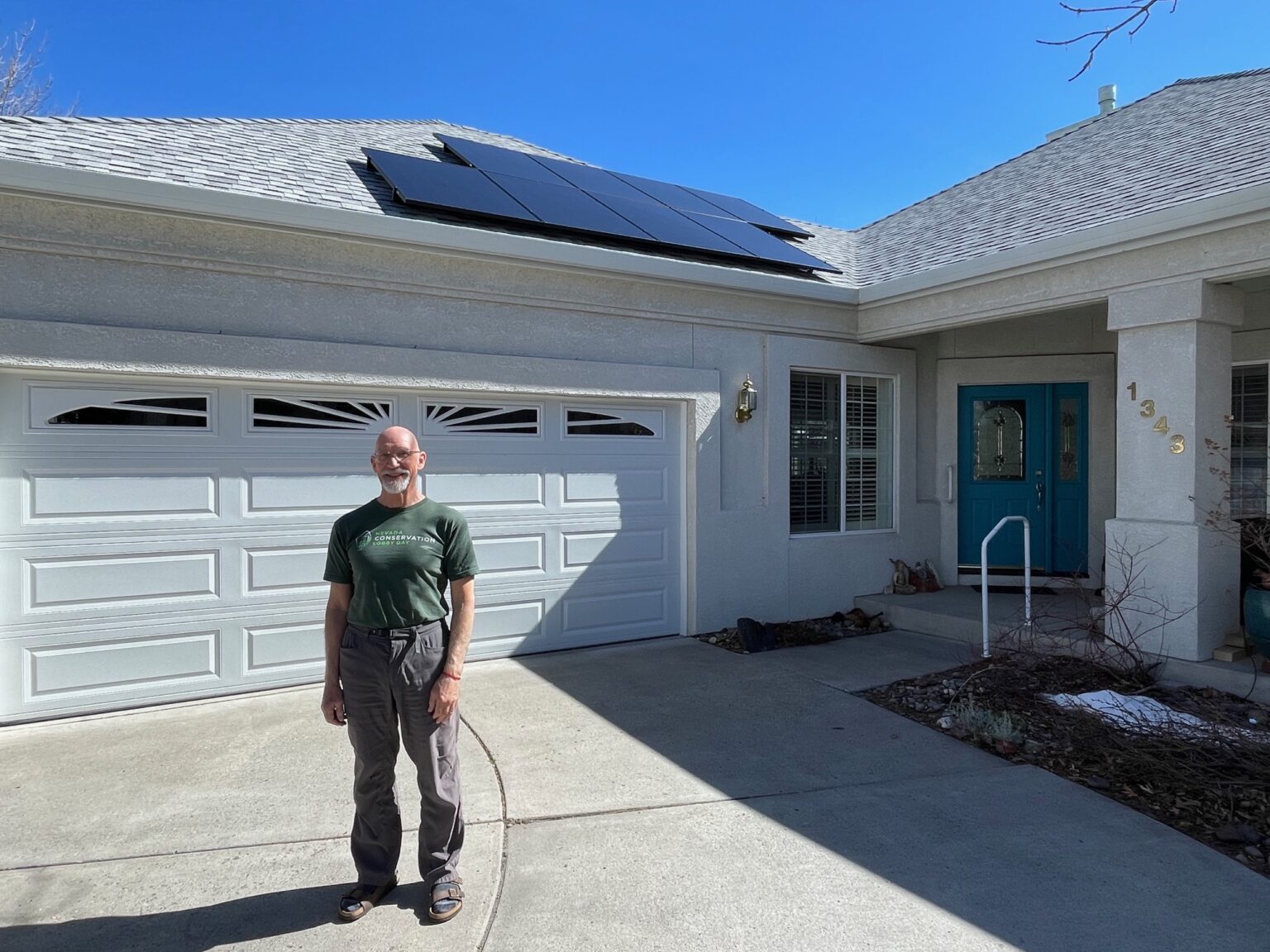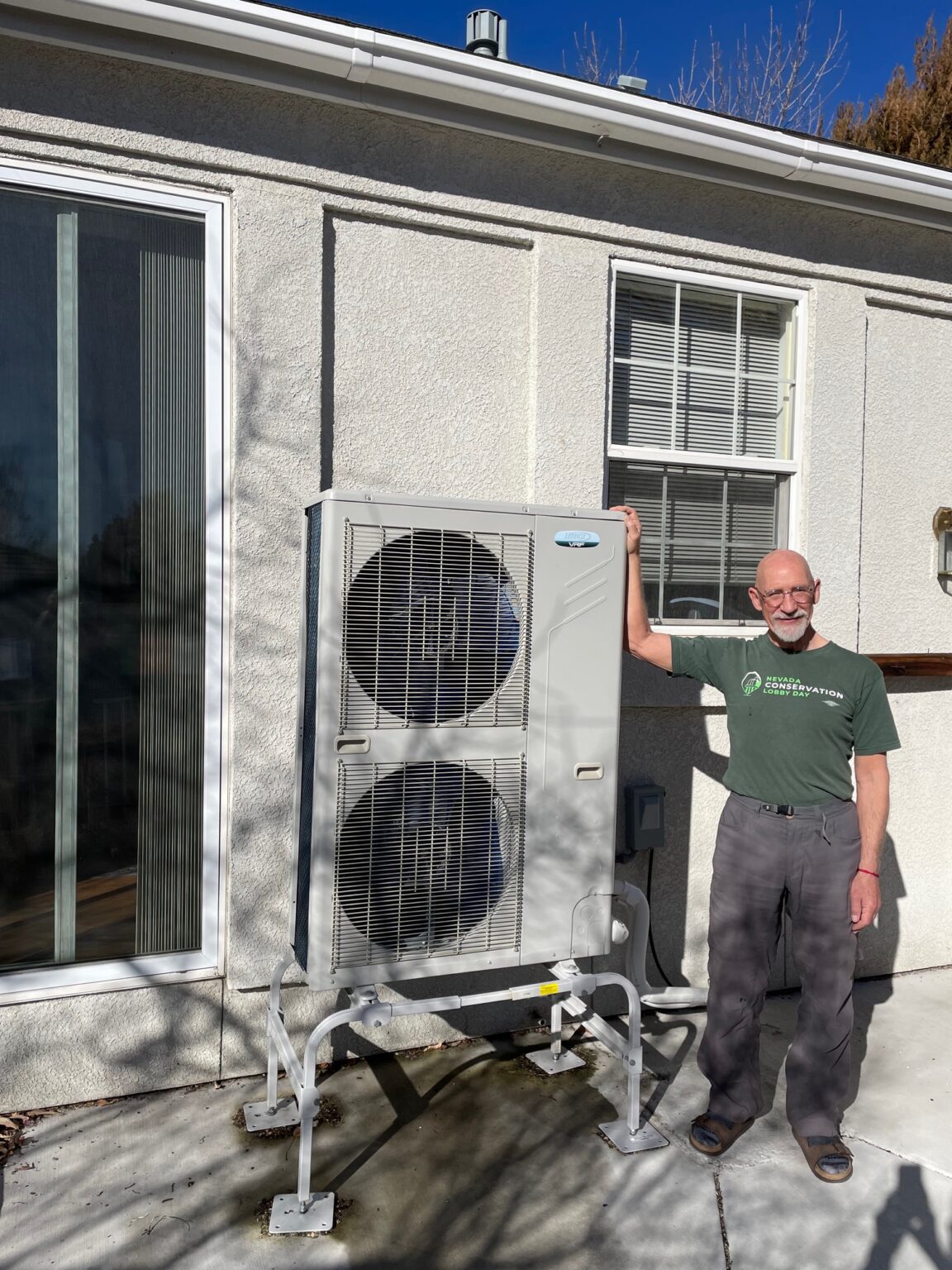A healthy home does wonders for a healthy life. Just ask Chas Macquarie, a retired civil engineer who lives with his wife, Anne, in a 26-year-old, 1840-square-foot home in Carson City. As a volunteer with Citizens Climate Lobby, Chas knows the urgency of addressing climate change and our individual roles in mitigating the adverse effects of burning fossil fuels.
But Chas had other concerns. Faced with rising natural (methane) gas costs and troubling reports about the harmful effects of by-products like nitrogen oxide, carbon monoxide, and methane, he and Anne decided to take control. Their journey to a fully electrified home was not just a choice – it was a mission.
A solid foundation for a sustainable home: Starting with a comprehensive home energy audit
In 2021, Chas and Anne started with a rigorous home energy performance audit, akin to a comprehensive health check-up for their home. They opted for Energy Masters, a certified home energy assessor did attic, crawl space, and room-by-room inspections to pinpoint leaks, and energy inefficiencies, and other problem areas.

Chas Macquarie is pictured above, standing in front of his heat pump powered home in Carson City, NV!
Chas offers some advice: While some energy audits can be free, “you need someone to crawl up into your attic and down into your crawl space to really see where heat is escaping.”
For Chas and Anne, the decision to prioritize a comprehensive home energy audit proved to be the cornerstone of their electrification journey. By laying this foundation, they could proceed with confidence, knowing that every subsequent upgrade was backed by data and designed to maximize their home’s efficiency, comfort, and sustainability.
Pro tip! Looking to get a home energy audit? Nevadans can get a $150 tax credit for an audit completed in the next 10 years, a provision in the Clean Energy Plan.
That’s roughly 30% of the total cost!
Read more about the Energy Efficient Home Improvement Credit from the IRS and all available clean energy tax credits.
The audit recommended more insulation in the attic, sealing all exterior openings in the crawl space, and sealing all their heating ducts and registers. Sealing leaks and upgrading insulation delivered an immediate reduction in their energy expenses, proving that sometimes the best solutions are also the most straightforward.
“Making our home more energy efficient was the biggest bang for the buck in reducing our energy bills,”
Chas Macquarie
Embracing Efficiency and Electrification
Next, they tackled their home’s biggest energy hog, the heating and air conditioning system. Since Chas and Anne’s failing gas furnace and AC unit were already 23 years old and due for replacement, they converted to a high-efficiency electric heat pump – a move that paid off handsomely. The energy-efficient unit they chose cost $12,500, just $500 more than a neighbor paid for a replacement gas furnace. Combined with $2,000 in tax credits provided by the Biden administration’s Clean Energy Plan (CEP), the conversion was even more affordable.

Chas, right, is pictured here standing next to their newly installed heat pump outside their home in Carson City.
They noticed energy savings immediately, with a dramatic reduction in their heating bill. “We have already saved more than $900 in two winters’ reduced energy bills, and we will save $450 a winter going forward,” said Chas.
They didn’t stop there. In 2022, they took advantage of solar energy incentives and tax credits to install solar panels on their roof, slashing their electric energy bill to an average of only $18 per month. This would have been impossible with a gas furnace.
The following year, Chas and Anne continued their energy efficiency campaign, replacing their ancient gas dryer and stove with electric models, which not only cut costs but also eliminated hazardous pollutants from their home. “We love it!” Chas beams. “The new stovetop simmers better and heats faster than our gas cooktop ever did.”
To finalize their journey to full electrification, Chas and Anne replaced their gas water heater with an electric one. The couple intended to wait a year or two, but when Southwest Gas bills began to skyrocket and charge $85 per month for water heating, Chas and Anne converted to an electric heat pump water heater. In doing so, they could also take advantage of the federal clean energy tax credit.
Chas and Anne’s Savings Breakdown
Chas and Anne invested in a healthier, more sustainable, clean energy home. They made the following improvements:
- Weatherization: More insulation in the attic, sealing all exterior openings in the crawl space, and sealing heating ducts and registers
- Electric heat pump for heating and cooling home
- Electric induction stove top
- Electric clothes dryer
- Solar panels
- Heat pump water heater
The cost of changing these systems and appliances to electric versions totaled about $24,400, plus $15,700 for the solar panels after the tax credit. It’s crucial to recognize that the appliances Chas and Anne replaced were already approaching the end of their useful life and would have required replacement soon, irrespective of their decision to fully electrify their home. However, undertaking this journey enabled the homeowners to proactively explore cleaner, more energy-efficient appliance options and take advantage of available incentives before the replacements became imminent.
The homeowners have eliminated their gas bill entirely, and Chas points out, “As near as we can figure, ignoring the solar panels, we are saving about $1,500 a year on energy bills.”
In the meantime, by weatherizing their house, sealing air leaks, and eliminating gas fixtures, they can make their home more comfortable and toxin-free, and the cost savings will last for years.
Reflecting On The Journey
By ditching natural gas, Chas and Anne didn’t just meet their goals—they exceeded them. They’ve dramatically reduced their carbon footprint, slashed their energy costs, and transformed their home into a toxin-free sanctuary. Their advice to their neighbors: With the Clean Energy Plan’s tax credits and other rebates, the time couldn’t be better to start your own conversion journey.
Still, $24,300 can be a steep cost for many families. Chas gives some advice: “One important thing to remember is that you do not have to make all these changes at one time. We did it over 3 years, but you can do it as appliances and heating systems wear out.”
Households can discover more about energy-efficient appliances and home energy upgrades before an appliance needs to be replaced. It’s important to be proactive.
Build A Better Home For You and Your Family
Imagine a home that’s not only more comfortable but also healthier and more energy-efficient. Say goodbye to chilly drafts and welcome lower utility bills and improved indoor air quality. Like Chas and Anne, you can leverage the Clean Energy Plan’s incentives to make your home a beacon of sustainability (see chart below). For low and middle-income families, there are also more substantial upfront rebates for heat pump heating and cooling. See what you may qualify for with this Rewiring America calculator.
Why Weatherize & Electrify?
- A healthier, more comfortable home
- No more cold winter drafts or summer A/C leaks
- Improved indoor air quality
- Lower monthly energy bills
- Reduced carbon footprint
Available Tax Credits
The federal clean energy tax credits are available to Nevadans now! Read below for how residents can lower their federal taxes by upgrading appliances and equipment.
Savings:
- Up to $2,000 for heat pumps (HVAC and water heater)
- $1,200 for energy property costs and certain energy-efficient home improvements, including:
- Up to $250 per door and $500 total
- Up to $600 for windows
- Up to $150 home energy audits
Savings:
- Credit equal to 30% of the purchase and installation costs for:
- Solar electric panels
- Solar water heaters
- Wind turbines
- Geothermal heat pumps
- Fuel cells (Up to $500 for each half kilowatt)
- Battery storage technology (beginning in 2023)
Savings:
- Up to 30% of the total cost of installing an electric vehicle (EV) charger at your home. The tax credit is capped at $1,000.
Savings:
- Up to $7,500 toward brand-new American-made electric cars, with a maximum MSRP of $55,000, and new vans, pickup trucks, and SUVs, with a maximum MSRP of $80,000.
- Starting in 2024, this credit can be transferred to dealerships in exchange for a point-of-sale discount.
- See the IRS website for qualified vehicles.
- New EV purchases are subject to income caps based on income tax filing status.
Savings:
- Up to $4,000 toward used EVs, including cars, SUVs, and light-duty trucks, with a sale price of $25,000 or less.
- Used EV purchases are subject to income caps based on income tax filing status.
Upcoming Rebates
President Biden’s Clean Energy Plan designates $8.5 billion to states and territories for Home Energy Rebates. These rebates help make home energy upgrades more affordable to homeowners, landlords, and renters by providing upfront discounts on electric appliances and other efficiency upgrades. Nevadans can expect the program to be available 2025!
Electric Appliances — up to $14,000 per household
- $4.5 billion from the IRA is reserved for discounts applied when you purchase electric appliances or supporting systems. These rebates can cover up to 100% — up to $14,000 — of the costs for electrification projects for low-income consumers and 50% for moderate-income consumers. Within the $14,000 per household limit, individual upgrades are subject to the following caps:
- Heat Pump – $8,000
- Electric Load Service Center – $4,000
- Electric Wiring – $2,500
- Heat Pump Water Heater – $1,750
- Weatherization – $1,600
- Electric/Induction Stove – $840
- Heat Pump Clothes Dryer – $840
Home Efficiency Improvements – $2,000 to $8,000 per household or more!
- The Efficiency Rebates program sets aside $4.3 billion for energy-efficient upgrades. Homeowners and landlords can work with contractors to access these discounts on whole-home energy efficiency upgrades — adding insulation and air sealing, plus new, more efficient appliances. If you’re a renter, this is a great opportunity to let your landlord know how these upgrades could make the property more energy efficient while reducing energy expenses.
- Qualifying for these benefits involves a property owner hiring a contractor to estimate projected energy savings. Higher energy savings will enable even higher rebate levels.
- If the upgrade is modeled to save 35% or more energy, you can get up to $4,000 or 50% of project costs, whichever is less.
- If the savings are modeled between 20% and 34%, you can get up to $2,000 or 50% of project costs, whichever is less.
- Measured energy savings allow for uncapped rebates — the more you save over 15%, the larger the rebate — and builds in accountability for achieving promised savings.
- Low-income households (earning less than 80% of the Area Median Income) receive double incentives, up to 80% of project costs.
